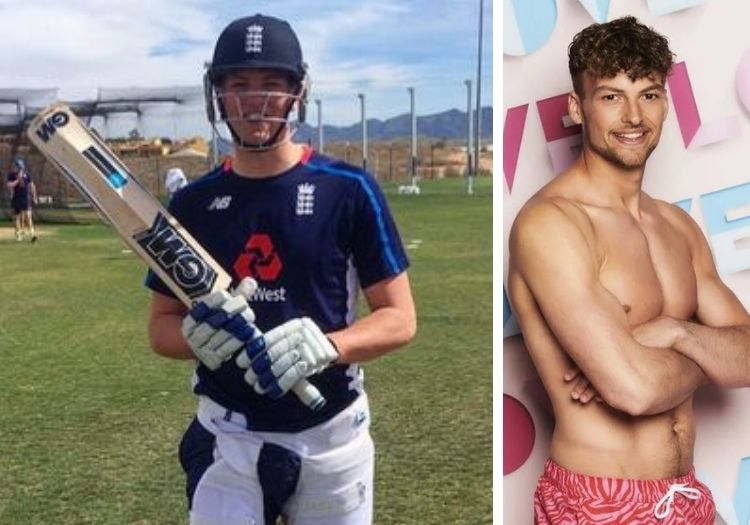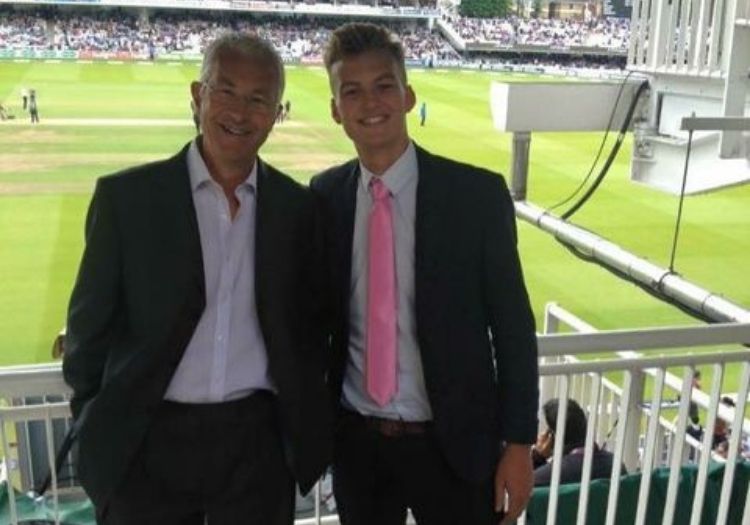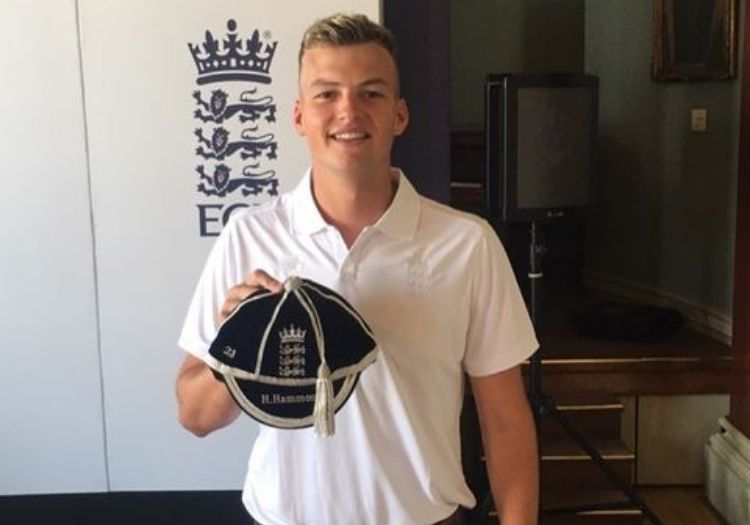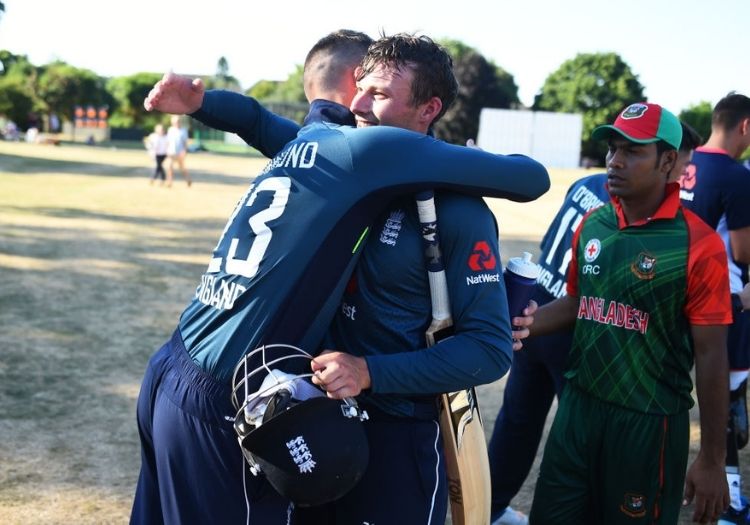Outperforming Ollie Pope, channelling Michael Jordan, ill-judged Dilscoops and a period in a wheelchair. NICK HOWSON speaks to family members and cricketing colleagues past and present to help tell the sporting tale of the Love Island entrant


To fully appreciate the direction an individual is heading, you need to understand where they have come from.
Over the coming weeks and months, Hugo Hammond will be littered across screens, feeds and minds.
Some of that attention will be pleasant, other aspects might be unsavoury.
It isn't in Hammond's character to shy away. A desire to battle adversity head-on, whether it be a physical disability or a snarling fast-bowler runs thick through his veins.
He enters the Love Island circus as its first disabled contestant. For a 24-year-old who has made the most of every opportunity presented to him, this is just another boundary easily cleared.
Obstacles have been laden across his life, both sporting and personal. This is the unairbrushed story of his cricketing journey, the difficulties, the classic innings, the bravado, arrogance and talent.
He has entertained many and upset others. It's been a thrilling ride that shows no sign of slowing down. Strap in for more of the same.
It should have been impossible for Hugo Hammond to play sport; unfeasible to rule the game of cricket and to win an ICRC world title with England alongside his brother; unworkable to become a batting marvel and a masterful wicketkeeper; and unimaginable that a troubled childhood could start the path towards an eye-catching career.
Born with a hereditary condition commonly known as clubfoot (or talipes), that parents Simon and Antonia were partly prepared for given older sibling Alex's previous diagnosis, he began life swimming against the tide.
In layman’s terms, talipes is when an infant is born with feet turned inwards. There are various degrees of severity. It can be corrected completely or partially with early treatment. But not in the case of Hammond junior.
"His feet were absolutely terrible," father Simon told The Cricketer. "The surgeon said they were the worst he'd ever seen. We were told the chances of him being able to play sport or run were minimal.
"But I like a challenge."
That gloomy prognosis started a lengthy run of surgeries which saw his Achilles and tendons in his foot cut and stretched. After each procedure, his foot would be placed in plaster for three months. Hammond underwent that process on each leg five times between the age of seven months and five years old.
Every operation failed to reach the desired outcome. And by now other issues were surfacing. The misalignment of Hugo's kneecap and heel meant he needed derotational osteotomy to readjust them, a process by which each leg was broken and set for four months at a time. Make that 12 times under the knife before he's turned seven.
Now for some better news. With triple arthrodesis, permanent securing of each foot ruled out due to Hugo's sporting ambitions, Ilizarov frames were fitted. It meant a year in a wheelchair, with each foot placed in plaster thereafter. But it ended with functional movement and was deemed to be an incredible success.

Hugo pictured with father Simon at Lord's (Instagram/hugo_hammond_)
Simon and Antonia had been unable to trigger the procedure themselves, having to wait until Hugo found his pain too much to bear and could make the decision himself.
That process included Hugo having to be carried from the middle by his dad sometimes while wearing the frames.
Indeed, by now cricket had become the central pillar of Hammond's existence.
"It was everything," added Simon. "He could see that he could compete with other people. As an infant, on sports days he was always given a headstart because he could not run. That made him stand out and different.
"He realised he could stand still, or as still as he could, and discovered that if you hit the ball to the boundary he didn't have to run. And that is Hugo's game.
"The reason he wanted to keep wicket was that it meant he didn't have to run in the field. It was a natural position for him."
His talents were first on show at Wield CC where he played soft-ball cricket between the ages of seven and nine.
It was under the stewardship of the late Wasim Raja at The Heights that Hammond hit perhaps the most eye-catching innings of his life, aged 10. He struck a fluid 96 in a T20 match batting alongside Ollie Pope, the future England and Surrey batter, who scored just 30.

Hammond's England call-up following trials and plenty of interest (Instagram/hugo_hammond_)
Hammond shaped his style around his limitations. Unable to plant his feet, he dances around the crease, opening up unique angles and has the timing to match.
It was at Lord Wandsworth School and College and later at Alton CC where Hammond first played with Toby Salmon, who recalls a confident and risk-taking right-hander even at an early age.
"You never really knew what was going to happen which always very nerve-wracking," Salmon said of standing at the other end.
"I remember one time when he was about 11 or 12 he tried to do a Dilscoop off a pace bowler.
"He connected with one and that made him even more confident. There were also times when he tried to do a quick single, slipped, fell on his backside and got run out. There were highs and lows certainly.
"Nothing phased him. He was a guy who had a certain amount of limitation, but you wouldn't think it. He went head-first into many things."
A century for Lord Wandsworth against MCC provoked praise from John Stephenson, a display he described as "a great performance" amid a chase of 241 to win.
Naturally, wider recognition followed quickly. He joined the Hampshire disability team, where he remains and was part of the side that won the national 40-over championship in 2012.
It is easy to forget that while pursuing the summit of cricket's increasingly improving disability sector he was playing against able-bodied first XIs by the time he was 18 at the likes of Hook and Newnham and Alton, and continues to do so.
It was at Hants where he first met close friend Dan Reynaldo during a trial weekend at Dummer Cricket Centre. "He was clearly a very talented cricketer then, he's always been around cricket," he said of his early impressions. "He's got a good mind and a lot of the team look to him for advice and it shows on the pitch."
Physical Disability coach at Hampshire Nick Wheeler found Hammond impossible company due to his limitless talent.
"When you go into physical disability cricket you have an idea of what you're going to come across," he explained.
"As soon as he gets a bat or behind the stumps, his ability is incredible. He hits the ball anywhere he wants to. He is one of those players, and a few of them play for England now, who is a step up above the rest in the disability world. His shot selection is incredible, and his knowledge is brilliant."
"It's a pleasure to coach but it is also quite hard. If someone is a better player than you are it is hard to pass on any knowledge. If there are any weaknesses in his game, he is on it straight away, he wants to better himself and he pushed that on you.
"I don't particularly like doing throw-downs to him; it's not that fun."
Then England cottoned on. Trials turned into a first call-up in 2015 for the International Committee of the Red Cross International T20 Tournament, at the time the closest to a World Cup for the disability cricket sector. It was the first multi-team tournament of its kind.
Following his appointment in 2014, coach at the time Qasim Ali had been notified of Hammond's emergence and immediately took an interest.
"I was talking to the management staff and the names of Jos Buttler, Sam Billings, Jason Roy came up in terms of how he used to strike the ball. He had a natural ability," he explained. "He is a very gusty player, dynamic, is ready to play, is flamboyant and plays cricket with lots of intent.

Alex and Hugo were the first brothers to represent England's disability team (Instagram/hugo_hammond_)
"He was very important to that team. Because of the reliability behind the stumps, so much quality. He added depth and structure to the batting line-up. And he was the prankster of the team. He had a very happy-go-lucky, flamboyant style or making jokes. He became a very likeable person from the outset. He can come across as abrupt, but he was an important character."
Then captain Ian Nairn had a similar experience. "If he was able to face 120 balls, he'd want to finish with 720," he recalled. "Everything wants to go out of the park. That is not to say he's not a sensible cricketer, but he likes to be powerful. He hits a clean ball; he has long levers. He wants to be dominating and controlling the game with the bat."
"It might look a little bit odd compared to the greats playing Test cricket, but it isn't half effective. When you feel the power that he puts into a ball, and the hand-eye coordination that he has from a less stable base is really impressive."
After losing the opening game to hosts Bangladesh, victories over India, Pakistan and Afghanistan booked a place in the final. Pakistan were beaten for a second time to secure victory. Hammond went the whole competition without conceding a bye, sometimes facing as many as 16 overs of spin in each game in alien conditions.
It was a double celebration for the Hammond family, with Hugo having joined establish member Alex in the squad as the first brothers to represent the England PD side.
"At the time we took it granted," admits Alex, who is 20 months Hugo's senior. "Looking back now, we always did things together so for Hampshire we won national titles, played together at Wandsworth, Alton; looking back on it only now do you think it was special. We probably should have enjoyed it more.
"I don't think we enjoyed it as much as we could have done. We lost that first game then had to win all our games to win the title. It was a hard graft that series, physically and mentally quite draining."
The following year saw Hammond begin a sports coaching degree at Oxford Brookes University, but his performances in the middle went from strength to strength. He became a social media sensation thanks to a remarkable helicopter scoop playing for his country in Dubai in 2016, a shot that highlighted his fluid range of motion at the crease as well as his imagination.
#Video: अरे ये क्या है भाई, इस शॉट को देखने के बाद आप भी यहीं कहेंगे - https://t.co/f71n30PYSY#HeliscoopShot #Cricket #HugoHammond pic.twitter.com/B0Myd2Z0LS
— Dainik Bhaskar Hindi (@DBhaskarHindi) September 11, 2017
At home, the thrilling performances continued. Hampshire chief Wheeler remembers a thrilling knock against Essex with Hammond batting down at No.4.
"It was clean-hitting, there were a couple of dirty slogs I will admit, you don't get that sort of knock without one or two dirty shots," he retold of the 27-ball 70 not out. "The ability to consistently hit the ball that cleanly and hit that many boundaries in that time. He's done that on several occasions, helping out the Hampshire team by playing that role as the aggressor, the guy who will score quick runs when you need it."
Meanwhile, at Alton in 2017 he produced another performance for the ages against Hursley Park. "Smashed the ball to all parts," said Salmon, speaking about an effort of 122 not out in a successful chase of 222. "He was on 99, when there might be a few nerves or you might want to get a quick single or whatever and he walked down the wicket and to a pace bowler, hit him over his head for four and just looked over at all of us with his arms in the air. He looked unbelievable that day."
Somewhat bafflingly, it was during this period when Hammond's England career was derailed. Ali was replaced by assistant coach Ian Salisbury, who within a year left out Hugo and was turned down by Alex as the Hammond era ended.
Added Nairn: "As a character, he was someone who needed to be a dominant part of the team. Where he wasn't able to it was potentially going to be part of the team full stop. That would be a fair reflection.
"It's a funny game, the disability game, because while an elite team representing England, we're also amateurs and we wear our hearts on our sleeves and don't always get to see the bigger picture, how a team goes together and how important teamwork is.
"Around the physical disability game, we might have had 20 players to pick from for a squad of 15, so we have to be more careful about the make-up of the squad. Hugo might refer to himself as a Kevin Pietersen-type character. He really wants to win, believes in his own ability and doing it his own way."
Alex, who still harbours hope of returning to the international scene with his brother, recollects: "There were a few 'yes' men in disability cricket and who would go with the flow.
"Hugo and I would stand up and challenge things. That was the way we were brought up: if you do not agree with something there is no point just going along with it.
"Deep down we are two very stubborn, at times selfish cricketers. Cricket is a selfish game and if you are selfish you tend to score more runs.
"Michael Jordan would push his teammates to be the best they could be, and I think that is what Hugo and I have driven to do. We may have rubbed some people up the wrong way but if we acted differently, I am not sure we would be true to ourselves. I have no regrets at all with what has happened."
Hammond naturally had the last word, signing off with 68 from 22 balls as England thumped a Rest of the World XI at Worcestershire's New Road. More recently he joined Hartley Wintney, where in 2019 he was part of the side that won the Guy Jewell T20 Cup before combining his teacher training course at Clyst Vale Community College and time as a PE teacher at Blundell's School in Devon with outings for Exmouth CC.
Before heading to Mallorca, Hammond produced what many have called his finest innings against Sussex for Hampshire's D40 side, scoring 103 in a victory secured with more than 19 overs of the 180 chase remaining.
"It was probably the best I've seen him bat if I'm being honest," said Reynaldo, who has been there throughout the Hammond journey. "It was 103 not out at the end and the power-hitting was enough to clear the ropes. At club level, he is always looking to clear the ropes and I've seen him get going with a couple of starts and it is pretty special.
"When he was batting with someone who was freeing their arms a bit, he would just take that on. That probably stems from the competition with his brother. He always wanted to get in on the action and if someone else is then he wants to hit it further."
Though it might appear that cricket is taking a backseat, few see it that way. Nearly 30 years on from England fielding their first disability team the sector has never been stronger.

Ian Nairn captained England until his retirement in 2019
The ECB last year reported that 70,000 disabled players were participating in the game across the country. In April, a £2 million investment was pledged to bring disability cricket to all 30 counties across England and Wales. By mid-May, more than 100 teams had signed up to the new Disability Cricket Champion club programme, which provides guidance, free equipment and online resources to support their disability arm.
Edgar Herridge, the ECB’s National Disabilities Manager, said: "If 20 per cent of society has a disability then where are they in our cricket landscape? In its simplest form, the programme offers more opportunity."
And now, one of their world champions is heading into the living rooms of millions of young people during the summer months. In the wake of the abuse suffered by Callum Flynn, there is an opportunity to change the narrative.
"It is going to shed light on disability cricket and the great work the ECB and the counties are doing," explained off-spinner Reynaldo. "It can only be a good thing in that sense. It might be difficult to see and read some of the negativity. Hopefully, on the flip side it can shine a light on how good it can be. If it can bring more eyes on the game that can only be a good thing."
Ali said: "Of all the England lads in the PD set-up, he's the one that I'd say would do something like this. Probably brave enough to do something like this, probably stupid enough to do something like this. From the Hugo that I know he will give some entertainment but at the same point but I'd like to see how he adapts to that environment."
"In Love Island, he'll be a huge success because it is about him," stated Nairn, who retired from England duty in 2019. "In 2015, he was a really dominant and strong part of the squad and participated with everyone in that environment. I guess people change as they go through university as they get into jobs and the like. Hopefully, on the show, he can display his great qualities.
"If he comes across brilliantly, it will be the best thing that has ever happened to disability cricket. If it doesn't go brilliantly it could be quite challenging for the game."
But Hammond likes a challenge.